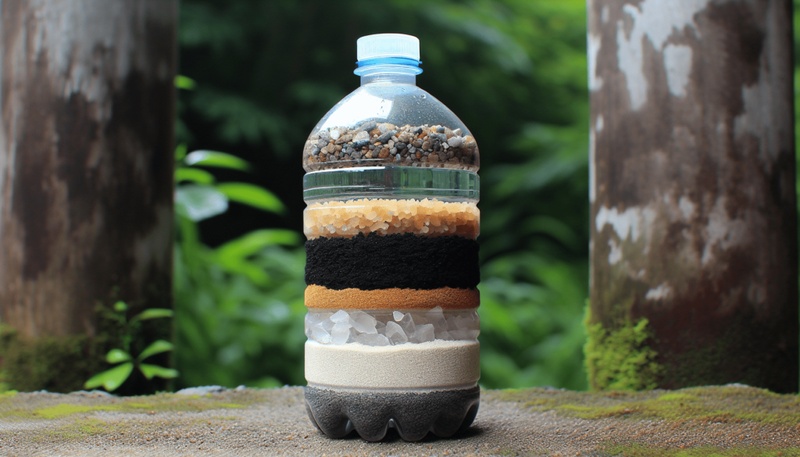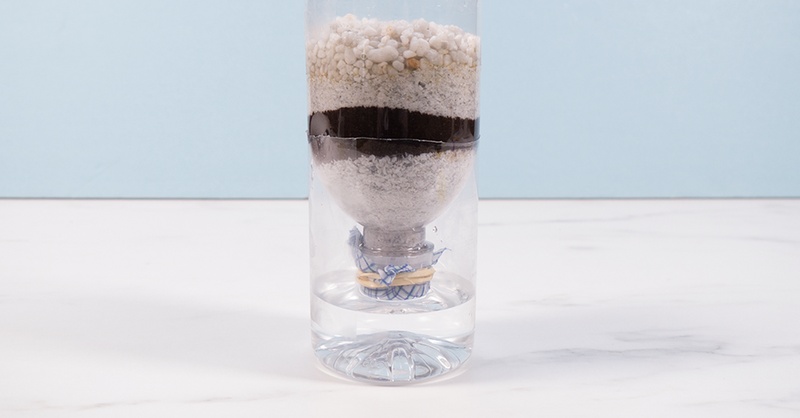Creating your own natural water filter offers an eco-friendly and cost-effective solution for obtaining cleaner water. These DIY systems utilize natural materials like sand, gravel, charcoal, and plant matter to remove impurities through methods similar to Earth’s natural filtration processes. Natural water filters can be built with readily available materials and are valuable for emergency preparedness, off-grid living, educational purposes, or reducing reliance on plastic bottles. This guide explores different DIY natural filtration methods, materials needed, construction steps, and important considerations about their effectiveness and limitations.
Natural water filtration mimics Earth’s purification processes where water passes through layers of soil, sand, and rock. This mechanical filtration removes larger particles while biological and chemical processes address contaminants at the microscopic level. The primary mechanism involves physical straining where suspended particles become trapped as water moves through progressively finer materials.
In natural systems, beneficial microorganisms develop on filter media, forming a “biolayer” that helps break down certain contaminants. Adsorption also occurs when impurities stick to surfaces of materials like activated charcoal through electrostatic attraction. These combined processes can effectively remove sediment, some pathogens, and certain chemicals from water sources.
Content Navigation
Benefits of DIY Natural Water Filters
- Cost-effectiveness – Natural filters utilize inexpensive, readily available materials
- Environmental sustainability – Reduces plastic waste from commercial filters and bottled water
- Emergency preparedness – Provides a water treatment option during disasters
- Educational value – Demonstrates natural filtration principles
- Self-sufficiency – Reduces dependence on municipal systems or commercial products
- Customization – Easily modified based on specific water concerns and available resources
- No electricity required – Functions without power, ideal for remote locations
These systems are particularly valuable in areas with limited access to clean water infrastructure or during emergency situations when conventional water treatment may be unavailable. They also serve as practical teaching tools about water conservation and environmental science.
Materials for Natural Water Filters

Natural water filters typically incorporate several filtering media, each serving a specific purpose in the purification process. The effectiveness of your filter largely depends on the quality and arrangement of these materials.
| Material | Function | Sourcing Tips |
|---|---|---|
| Gravel | Removes large debris and supports filter layers | Use clean, rinsed landscape gravel or river rocks |
| Sand | Filters smaller particles and supports biological filtration | Clean, coarse sand (sandbox or construction sand) |
| Activated Charcoal | Adsorbs chemicals, improves taste and odor | Available at aquarium shops or make by burning hardwood |
| Clay | Traps bacteria through small pore size | Use pottery clay without additives |
| Cotton/Coffee Filters | Pre-filters larger particles | Standard household items |
| Plant Materials | Can add antimicrobial properties | Pine needles, certain leaves, moss (research compatibility) |
For containers, consider using plastic bottles, food-grade buckets, ceramic pots, PVC pipes, or glass containers. Ensure all materials are thoroughly cleaned before use, especially if repurposing containers. Natural materials should be collected from unpolluted sources and properly prepared to avoid introducing new contaminants.
Types of DIY Natural Water Filters
Biosand Filters
Biosand filters use layers of sand and gravel to remove contaminants through mechanical straining and biological action. The distinguishing feature is the biolayer that forms naturally at the sand’s surface after 1-3 weeks of use. This living layer of microorganisms consumes pathogens in the water.
These filters are typically built in concrete or plastic containers with defined layers of fine sand, coarse sand, and gravel. Water flows slowly through these materials, with pathogens removed by the biolayer and physical straining. Biosand filters can remove 95-99% of biological contaminants when properly maintained, making them one of the most effective DIY options.
Charcoal Filters
Charcoal-based filters leverage activated carbon’s powerful adsorption properties to trap impurities. Activated charcoal contains millions of microscopic pores that capture chemicals, some heavy metals, and compounds causing bad taste or odor. These filters are particularly effective at removing chlorine, volatile organic compounds (VOCs), and improving water taste.
DIY versions typically combine crushed activated charcoal with sand and gravel layers. While store-bought activated charcoal is ideal, homemade versions can be created by burning hardwoods like oak or maple in a low-oxygen environment, though commercial versions undergo specialized activation processes for greater effectiveness.
Solar Water Purification (SODIS)
While not technically a filter, solar disinfection is a natural purification method that uses UV radiation from sunlight to kill pathogens. The process requires exposing water in clear containers to direct sunlight for 6+ hours (or 2 days in cloudy conditions).
This method works best with transparent PET bottles filled with low-turbidity water. The combination of UV-A radiation and increased temperature inactivates bacteria, viruses, and protozoa. SODIS is most effective for small quantities of relatively clear water and is commonly used in developing regions for its simplicity and near-zero cost.
Clay Pot Filters
Clay pot filters consist of a porous ceramic container that physically strains water through microscopic pores. Traditional versions incorporate colloidal silver in the clay, which adds antimicrobial properties. Water slowly seeps through the clay into a collection container, leaving contaminants behind.
These filters effectively remove most bacteria, protozoa, and larger pathogens but may not remove viruses due to their smaller size. While professional ceramic filters are manufactured with precise specifications, simpler DIY versions can be made using local pottery techniques, though they may vary in effectiveness.
Step-by-Step Guide to Building a Basic Natural Water Filter

This guide outlines the construction of a simple multi-layer filter using a plastic bottle. This design incorporates the most common natural filtering materials in an easy-to-build format.
- Gather materials: 2-liter plastic bottle, scissors, clean cloth/coffee filter, activated charcoal, fine sand, coarse sand, small gravel, larger rocks.
- Prepare the container: Cut the bottom off the plastic bottle. Turn the bottle upside down (with cap on) to create a funnel shape.
- Create drainage: Remove the bottle cap and place the cloth/coffee filter over the opening, securing it with string or rubber band.
- Add filter layers: Starting at the neck (now bottom) of the inverted bottle, add materials in this order:
- 1-2 inches of activated charcoal
- 2-3 inches of fine sand
- 2-3 inches of coarse sand
- 2-3 inches of small gravel
- 1-2 inches of larger rocks
- Wash the filter: Pour clean water through several times until the output runs clear.
- Setup the system: Place the filter on top of a clean collection container.
- Use the filter: Pour water slowly into the top, allowing it to gradually work through all layers.
For optimal results, pre-filter very turbid water through a cloth before using this system. Remember that while this basic filter will improve water clarity and reduce some contaminants, additional disinfection (boiling, solar, or chemical) is recommended for uncertain water sources.
Maintenance and Effectiveness

Proper maintenance ensures optimal performance and longevity of DIY natural filters. Regular cleaning prevents clogging and maintains flow rates. For multi-layer filters, the top layer typically requires the most frequent attention as it captures the largest particles.
Effectiveness varies significantly depending on design, materials, and source water quality. While natural filters excel at improving clarity and taste, their pathogen removal capabilities have important limitations:
| Contaminant Type | Effectiveness of DIY Natural Filters | Improvement Methods |
|---|---|---|
| Sediment/Turbidity | High (90-99% removal) | Multiple filtering stages, finer sand |
| Bacteria | Moderate to High (70-99% with biolayer) | Mature biosand filter, silver-enhanced clay |
| Protozoa/Parasites | Moderate to High (90-99%) | Fine filtering materials, proper maintenance |
| Viruses | Low to Moderate (50-90%) | Combined with disinfection methods |
| Chemicals/Toxins | Variable (20-90%) | More activated charcoal, specialized media |
| Heavy Metals | Low to Moderate (varies by metal) | Adding specialized media like zeolite |
For biosand filters, the biolayer takes 1-3 weeks to develop and must remain wet to stay effective. Use the filter regularly but avoid disturbing the top sand layer. When flow becomes too slow, carefully scrape and clean only the top 1-2cm of sand.
Limitations of DIY Natural Water Filters
While DIY natural filters offer valuable benefits, understanding their limitations is crucial for safety. These filters should not be considered complete water treatment systems for seriously contaminated water sources.
Most natural filters cannot reliably remove viruses, dissolved chemicals, heavy metals, or certain microscopic pathogens. Flow rates are typically slow compared to commercial filters, and effectiveness varies based on construction quality and material selection. For water of uncertain quality, combining filtration with a disinfection method like boiling, SODIS, or chemical treatment is recommended.
DIY systems also require regular maintenance and eventual material replacement. The biological layer in biosand filters must remain consistently wet to maintain effectiveness. For everyday drinking water in areas with known contaminant concerns (like industrial pollution), commercially tested filters or municipal treatment remain more reliable options.
Despite these limitations, natural water filters remain valuable for improving water quality in many situations, reducing turbidity, improving taste, and providing a measure of protection when other options are unavailable.
Tips for Getting the Best HVAC Prices
- Prioritize Quality Over Cost
The most critical factor in any HVAC project is the quality of the installation. Don’t compromise on contractor expertise just to save money. - Check for Rebates
Always research current rebates and incentives — they can significantly reduce your overall cost. - Compare Multiple Quotes
Request at least three estimates before making your choice. You can click here to get three free quotes from local professionals. These quotes include available rebates and tax credits and automatically exclude unqualified contractors. - Negotiate Smartly
Once you've chosen a contractor, use the proven strategies from our guide — How Homeowners Can Negotiate with HVAC Dealers — to get the best possible final price.

